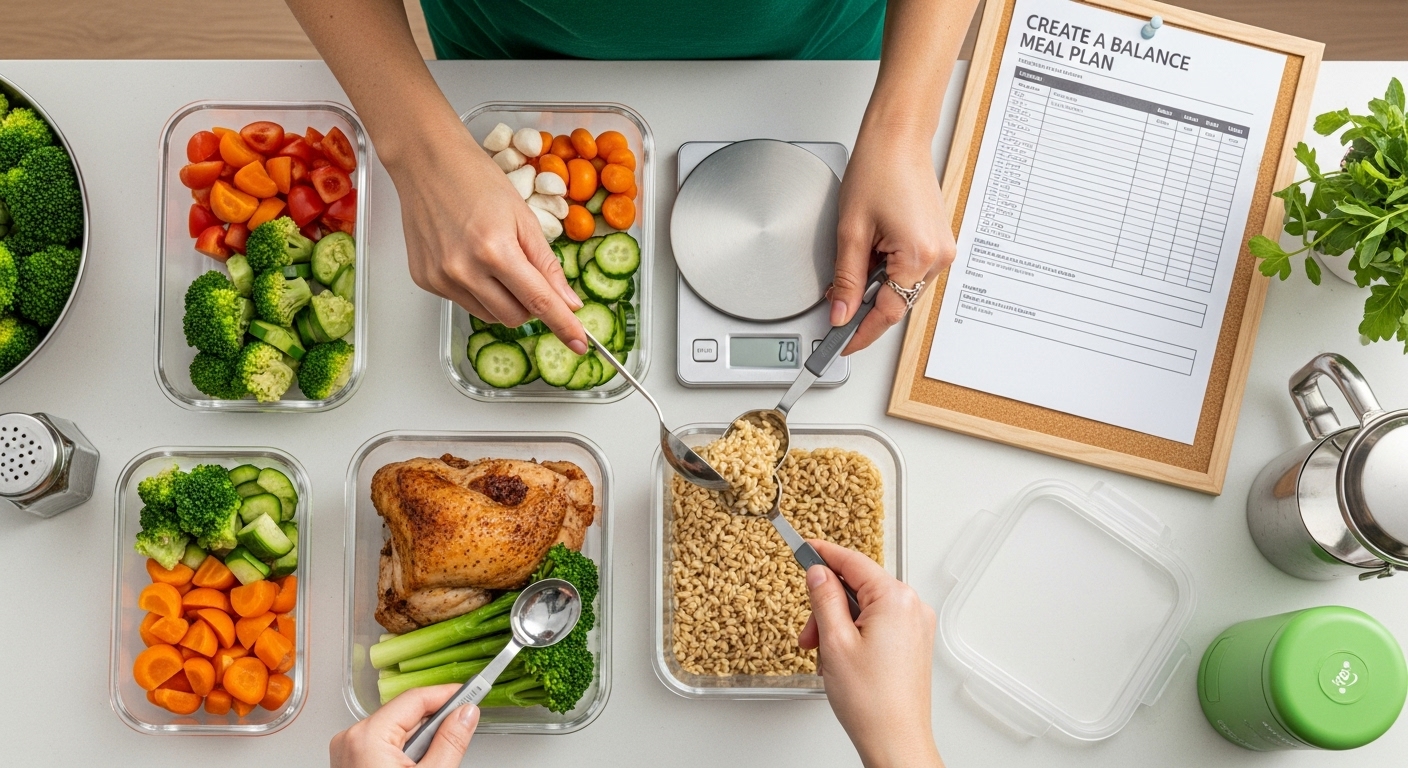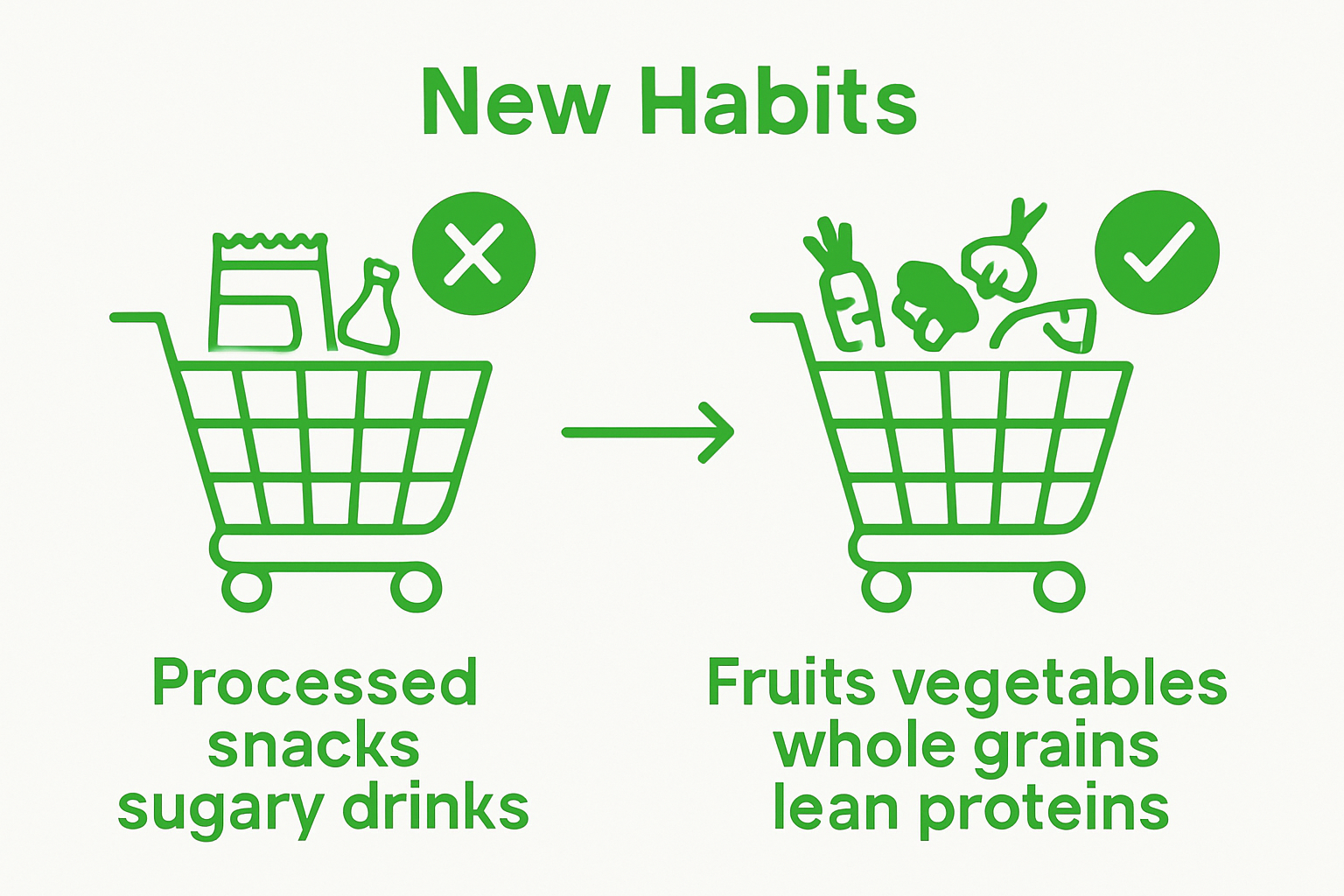Changing the way you eat may sound daunting, especially when routines feel set in stone. Yet tracking every single thing you eat for just one week can reveal patterns you had no idea existed. Most people expect the hard part to be giving up their favourite foods but the real surprise is how a simple week of honest food logging can spark changes that last far longer than any quick-fix diet.
Table of Contents
- Step 1: Assess Your Current Eating Habits
- Step 2: Set Realistic Health Goals
- Step 3: Create a Balanced Meal Plan
- Step 4: Shop for Healthy Ingredients
- Step 5: Prepare Nutritious Meals at Home
- Step 6: Monitor Your Progress and Adjust
Quick Summary
| Key Point | Explanation |
|---|---|
| 1. Reflect on Your Eating Habits | Track all intake for a week to identify dietary patterns and areas needing improvement. |
| 2. Set Specific, Achievable Goals | Use the SMART framework to create realistic objectives tailored to your personal nutrition challenges. |
| 3. Plan Balanced Meals | Ensure meals incorporate diverse food groups for essential nutrients, promoting enjoyable nutrition. |
| 4. Shop Mindfully | Prepare a shopping list aligned with your meal plan to avoid unhealthy impulse purchases. |
| 5. Monitor Progress Regularly | Keep a comprehensive health journal to assess emotional and physical changes as you refine your diet. |
Step 1: Assess Your Current Eating Habits
Starting your journey to eat healthily begins with honest self-reflection about your current nutritional patterns. Understanding your existing eating habits provides the essential foundation for meaningful dietary transformation. The National Heart, Lung, and Blood Institute recommends a comprehensive review of your typical meals and snacks to identify potential areas for improvement.
To effectively assess your current eating habits, start by documenting everything you consume for an entire week. This means tracking every meal, snack, beverage, and even those small bites you might normally overlook. Use a dedicated notebook or a digital food tracking app to record each item, including portion sizes and preparation methods. Be brutally honest with yourself during this process no editing or modifying your typical choices.
As you compile your food diary, look for consistent patterns that might indicate nutritional challenges. Are you consuming excessive processed foods? Do sugary snacks dominate your afternoon routine? Are your portion sizes significantly larger than recommended serving sizes? Pay attention to emotional eating triggers, stress-related consumption, and times when you might be eating out of boredom rather than genuine hunger.
Carefully analyse your documented week of eating by categorising foods into groups: whole foods, processed items, fruits, vegetables, proteins, and carbohydrates. This visual breakdown will help you identify nutritional gaps and areas requiring immediate attention. Consider the balance and variety of nutrients in your current diet. Are you getting sufficient vitamins and minerals? Is your protein intake adequate? Are you consuming enough fibre?
The goal of this assessment is not to shame or criticise your current eating habits but to create a clear, objective baseline for your upcoming dietary transformation. By understanding your existing nutritional landscape, you can make informed, strategic adjustments that feel sustainable and genuinely supportive of your health goals.
Step 2: Set Realistic Health Goals
Transforming your eating habits requires more than just good intentions it demands strategic, measurable objectives that align with your personal health journey. The National Heart, Lung, and Blood Institute emphasises the importance of creating small, achievable goals that build sustainable momentum.
Begin by reflecting on the insights gained from your food diary in the previous step. Your goals should address specific nutritional gaps or challenges you identified. Instead of setting broad, overwhelming targets like completely overhauling your diet overnight, focus on incremental changes that feel manageable. For instance, if your assessment revealed minimal vegetable intake, your initial goal might be introducing one additional serving of vegetables into your daily meals.
Consider creating a SMART framework for your health goals: Specific, Measurable, Achievable, Relevant, and Time-bound. This approach transforms vague aspirations into concrete action plans.
Rather than saying “I want to eat healthier,” craft a precise goal like “I will replace processed snacks with whole fruit or vegetable options for my afternoon break, starting this week and continuing for the next month.”
Your health goals should also account for your individual lifestyle, preferences, and potential obstacles. If you have a demanding work schedule, design goals that accommodate your time constraints. Perhaps meal prepping on weekends or identifying quick, nutritious alternatives that fit your routine would be more sustainable than complicated cooking strategies.
Documenting your goals is crucial. Write them down in a dedicated notebook or digital tracker where you can monitor progress and make adjustments. Visual representation helps maintain accountability and motivation. Remember that flexibility is key your goals are not rigid commandments but adaptive guidelines that can evolve as you learn more about your nutritional needs and personal health journey.
Step 3: Create a Balanced Meal Plan
Crafting a balanced meal plan transforms your nutritional strategy from abstract goals into practical daily actions. The World Health Organization highlights the critical importance of dietary diversity and nutrient balance in maintaining optimal health.
Begin by understanding the core principles of nutritional balance. A truly balanced meal plan incorporates diverse food groups in appropriate proportions, ensuring your body receives essential nutrients. Think of your plate as a canvas where proteins, complex carbohydrates, healthy fats, and abundant vegetables create a harmonious nutritional landscape.
Design your meal plan with deliberate variety to prevent monotony and nutritional deficiencies. Each day should include lean proteins like chicken, fish, legumes, or tofu; complex carbohydrates such as quinoa, brown rice, or sweet potatoes; an abundance of colourful vegetables representing different nutritional profiles; and healthy fats from sources like avocados, nuts, and olive oil. The goal is not rigid restriction but thoughtful, enjoyable nutrition.
Practical implementation requires strategic planning. Dedicate time each week to meal preparation, ideally selecting a consistent day when you can batch cook multiple components. This approach reduces daily decision fatigue and minimises the temptation of convenient but less nutritious options. Consider preparing versatile base ingredients like roasted vegetables, grilled proteins, and whole grains that can be mixed and matched throughout the week.
Remember that flexibility is key to sustainable eating. Your meal plan should not feel like a restrictive diet but a personalized nutrition strategy that adapts to your lifestyle, preferences, and occasional spontaneity. Allow room for occasional treats and social dining experiences, understanding that consistency not perfection drives long-term nutritional success. By approaching your meal plan as a dynamic, evolving tool rather than a rigid set of rules, you create a more enjoyable and maintainable path to healthier eating.
Below is an overview table summarising each main step for starting healthy eating, including the primary action and outcome to make the process easily scannable.
| Step | Main Action | Key Outcome |
|---|---|---|
| Assess Current Habits | Track food and beverage intake for one week | Identify patterns and areas for improvement |
| Set Realistic Goals | Create tailored SMART objectives | Establish manageable, motivating targets |
| Create Balanced Meal Plan | Incorporate diverse food groups and plan ahead | Ensure nutritional variety and consistency |
| Shop for Ingredients | Prepare a shopping list based on meal plan | Avoid impulse buys and stock healthy options |
| Prepare at Home | Batch cook and use healthy techniques | Gain control over nutritional quality |
| Monitor & Adjust | Journal progress and review monthly | Adapt strategies and celebrate achievements |

Step 4: Shop for Healthy Ingredients
Successful healthy eating begins long before you enter the kitchen it starts in the grocery store, where strategic ingredient selection becomes your foundation for nutritional transformation. The Harvard School of Public Health emphasises the critical role of mindful food selection in maintaining a balanced diet.
Prepare for your shopping expedition by developing a strategic approach. Before leaving home, review your meal plan and create a detailed list that aligns precisely with your nutritional goals. This preparation prevents impulse purchases and reduces exposure to unhealthy temptations. Consider understanding clean ingredients and their benefits to make more informed purchasing decisions that support your health objectives.
Navigate the grocery store with intentionality, spending most of your time in the perimeter sections where fresh produce, lean proteins, and whole foods are typically located. Avoid centre aisles packed with processed foods, which often contain high levels of sugar, salt, and artificial preservatives. When selecting produce, prioritise seasonal, vibrant fruits and vegetables that appear fresh and unbruised. Look for organic options when possible, especially for items known to have higher pesticide residues.
Read nutrition labels meticulously, paying attention to ingredient lists rather than just calorie counts. Seek products with minimal, recognisable ingredients. Be wary of items with long, complex ingredient lists filled with unpronounceable chemical names. Choose whole grain options over refined versions, select lean proteins, and opt for unsweetened versions of products like yoghurt and plant-based milks.
Remember that healthy shopping is a skill developed over time. Do not become overwhelmed by attempting perfection in a single trip. Start by making small, consistent improvements to your grocery cart. Each mindful selection brings you closer to your nutritional goals, transforming shopping from a routine task into a powerful act of self-care and wellness.

Step 5: Prepare Nutritious Meals at Home
Transforming your healthy ingredients into delicious, nutritious meals requires more than just culinary skills it demands creativity, planning, and a positive approach to home cooking. The American Heart Association emphasises the importance of home meal preparation in maintaining a balanced diet.
Meal preparation becomes your gateway to nutritional control. Start by establishing a consistent cooking rhythm that fits your schedule. Weekend batch cooking can be transformative, allowing you to prepare multiple meals that can be easily stored and reheated throughout the week. Invest in high-quality, gluten-free cooking utensils to ensure your cooking environment supports your health goals, particularly if you have specific dietary requirements.
Master a few fundamental cooking techniques that preserve nutritional value. Steaming, roasting, and grilling are excellent methods that require minimal added fats while maintaining ingredient integrity. Learn to season dishes with herbs and spices instead of relying on salt or processed sauces. This approach not only enhances flavour but also introduces additional health benefits through natural plant compounds.
Organise your kitchen to support healthy cooking. Create a dedicated preparation area with essential tools like a sharp chef’s knife, cutting boards, and storage containers. Develop a mise en place approach preparing and measuring ingredients before cooking which reduces stress and makes the cooking process more enjoyable and efficient. Consider investing in kitchen tools that make healthy cooking more accessible, such as a good quality blender for smoothies, a steamer basket, or an air fryer for lower-fat cooking options.
Remember that cooking nutritious meals is a skill that improves with practice. Do not be discouraged by initial challenges or imperfect results. Each meal is an opportunity to learn, experiment, and gradually build confidence in preparing delicious, health-supporting dishes. Approach home cooking as a form of self-care, a creative expression of your commitment to wellness that nourishes both body and soul.
The table below organises essential kitchen tools and their purposes as described in the home meal preparation section, helping you equip your workspace for efficient healthy cooking.
| Tool/Equipment | Purpose |
|---|---|
| Sharp chef’s knife | Essential for safe and efficient meal prep |
| Cutting boards | Keeps food preparation organised and hygienic |
| Storage containers | For storing batch-cooked meals and ingredients |
| Blender | To make smoothies and blend healthy sauces |
| Steamer basket | Enables low-fat cooking while preserving nutrients |
| Air fryer | Facilitates lower-fat cooking options |
| Measuring utensils | Ensures portion control and accurate recipes |
| Gluten-free utensils | Maintains kitchen safety for dietary needs |
Step 6: Monitor Your Progress and Adjust
Tracking your nutritional journey transforms abstract goals into tangible achievements, providing crucial insights into your evolving health strategy. The National Heart, Lung, and Blood Institute emphasises the importance of consistent progress monitoring and flexible adaptation.
Establish a comprehensive tracking system that goes beyond simple weight measurements. Consider maintaining a multifaceted health journal documenting not just physical changes, but also energy levels, mood, sleep quality, and overall wellbeing. Digital apps or a dedicated notebook can help you record these nuanced metrics, providing a holistic view of your nutritional transformation.
Schedule regular self-assessment intervals monthly is typically ideal where you critically examine your progress. During these check-ins, compare your current state against the initial goals you established. Look for patterns in your eating habits, noting which strategies worked effectively and which require modification. Be honest and compassionate with yourself, understanding that healthy eating is a dynamic process of continuous learning and adjustment.
Physical measurements offer valuable data points, but they should not be your sole indicators of success. Pay attention to how you feel, not just how you look. Improvements in energy, mental clarity, digestive comfort, and overall vitality are equally significant markers of nutritional progress. Consider consulting a nutritionist or healthcare professional periodically to provide expert insights and validate your personal observations.
Flexibility is key to sustainable dietary change. If certain approaches are not yielding desired results, view this as an opportunity for strategic refinement rather than failure. Your nutritional plan should evolve alongside your body’s changing needs, personal circumstances, and health objectives. Embrace this journey as a personalised experiment, where each adjustment brings you closer to optimal wellness.
Transform Your Healthy Eating Goals into Reality with Nature’s Soul Shop
Starting a journey to better eating habits can feel overwhelming, especially when trying to find clean ingredients and nutritious options that truly support your goals. In the article, you discovered the power of meal planning, ingredient shopping, and home cooking to make real changes. Yet, sourcing organic whole foods or gluten-free essentials can be a challenge, and it is easy to lose momentum without the right resources.

Ready to put your new skills into action? Tap into Nature’s Soul Shop for trusted options that fit your needs, from fresh produce and dry grocery to vegan, meats and dairy. Discover guides on understanding clean ingredients and their benefits and elevate your kitchen with tips for gluten-free cooking utensils. Start browsing at Nature’s Soul Shop today. Make every meal a step closer to healthier living—shop now and enjoy nutritious choices delivered to your door.
Frequently Asked Questions
How can I effectively assess my current eating habits?
To assess your current eating habits, document everything you consume for a week, including meals, snacks, and beverages. Analyse this food diary for patterns in portion sizes, food types, and emotional eating triggers to identify areas for improvement.
What are SMART goals and how can they help in my healthy eating journey?
SMART goals are Specific, Measurable, Achievable, Relevant, and Time-bound objectives that help clarify your health aspirations. For instance, instead of broadly saying “I want to eat healthier,” specify a goal like “I will add one serving of vegetables to my meals each day for the next month.”
What should I include in a balanced meal plan?
A balanced meal plan should include diverse food groups: lean proteins (like chicken or tofu), complex carbohydrates (such as brown rice or quinoa), a variety of colourful vegetables, and healthy fats (like avocados or nuts). This balance ensures you receive essential nutrients while enjoying your meals.
How can I monitor my progress while starting to eat healthy?
You can monitor your progress by maintaining a health journal that tracks not only your food intake but also your mood, energy levels, and overall wellbeing. Regular self-assessment intervals, such as monthly check-ins, can help you identify patterns and adjust your eating strategies accordingly.
Recommended
- Understanding What Are Clean Ingredients and Their Benefits – naturessoulshop
- Understanding Sustainable Agriculture Practices for a Better Future – naturessoulshop
- Are Fruits Gluten Free? Understanding the Basics – naturessoulshop
- Understanding Gluten Free Cooking Utensils: A Clear Guide – naturessoulshop






